关于遥感影像BIL、BIP、BSQ你知道多少?给一个二进制文件你会读取嘛~

由于微信公众号改变了推送规则,为了每次新的推送可以在第一时间出现在您的订阅列表中,记得将本公众号设为星标或置顶喔~
介绍了遥感影像通用数据格式BIP、BIL、BSQ,并给出MATLAB、C++从原始二进制数据读取影像的代码~
🌿前言
遥感影像的通用存储格式有BIP、BIL、BSQ三种,通常在编程处理图像时都会使用GDAL、Arcpy、Rasterio等库来进行读取,如果因某些原因使用不了这些库,又该如何解决呢?
本文先简单介绍了BIP、BIL、BSQ三种通用格式的区别,随后分析了如何正确读取二进制存储遥感数据,最后给出了MATLAB和C++读取参考代码。
文末有获取项目所有文件的方式~
🍀BIP&BIL&BSQ
BIP
BIP(Band Interleaved by Pixel),可以理解为按照像素存储,先依次存储每个波段的第一个像素,再存储每个波段的第二个像素…
BIL
BIL(Band Interleaved by Line),可以理解为按照行进行存储,先依次存储每个波段的第一行,再存储每个波段的第二行…
BSQ
BSQ(Band Sequential),即按照顺序存储,依次存第一个波段所有像素,再存第二个波段所有像素…
一图理解
下图应该能够很好的反映出存储的方式(按照对应的数字顺一遍就很好理解)
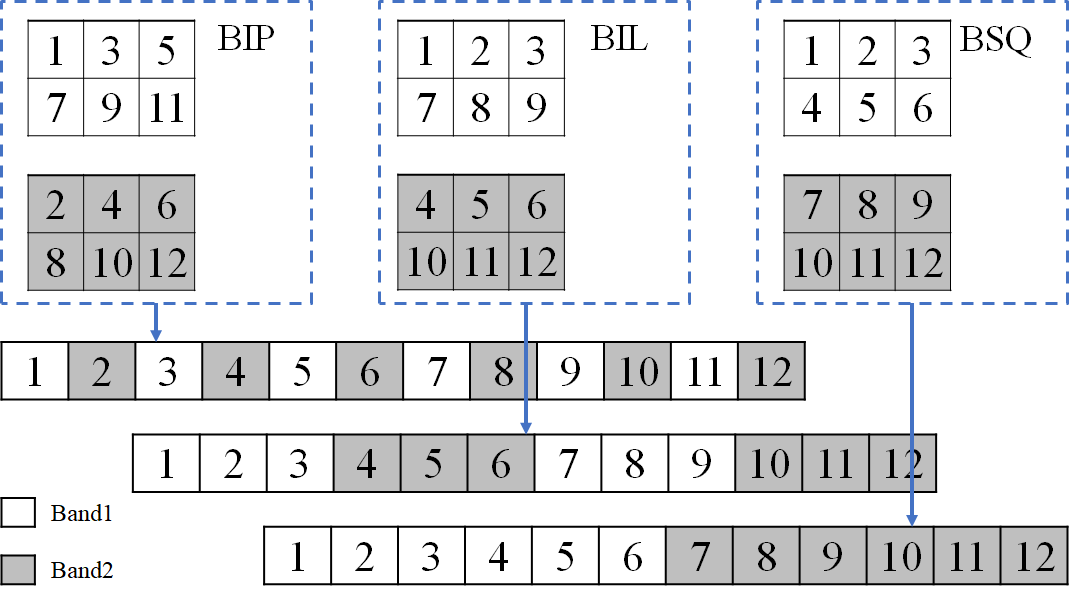
了解更多可以参考此链接:https://blog.csdn.net/m0_46387817/article/details/108467947
🌸数据读取思路
重要两点
有关如何正确地读取影像数据,笔者认为有两点是至关重要的:
- 弄清所读楚遥感影像的存储是BIP还是BIL还是BSQ
- 知道所读影像的数据类型:float、double
如果数据格式不正确,就会导致数据读取的有问题,例如一个存储类型是8位的数据按照16位的数据类型读取,就会直接导致读取到的数组大小发生改变,这个错误还容易发现。
如果数据格式存储的8位无符号整型,恰好又按照8位的整型去读取,读出来的数组大小一致,但是值已经是错误的值了。
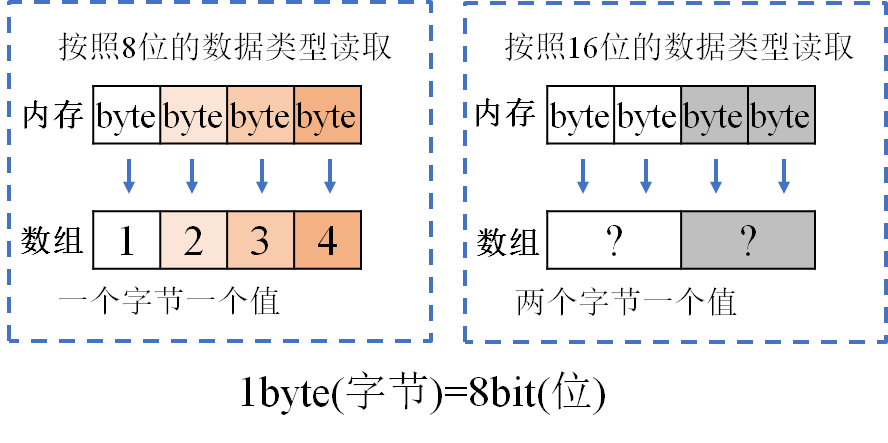
读取步骤
- 将数据从二进制文件中按照存储类型读到一维数组
需要根据影像的元数据文件或者一些属性信息,了解影像单个像元存储的数据类型,再利用一些读取二进制文件的函数例如MATLAB中的fopen和fread函数、C++中的ifstream函数将数据正确地读到一维数组。
- 根据BIP、BIL、BSQ对一维数组进行解析
根据索引关系将一维数组解析为对应的波段数组。
索引关系
关于如何建立一维数组和波段数组(三维)的关系,即建立一个
i
n
d
与
r
i
、
c
i
、
k
i
ind与ri、ci、ki
ind与ri、ci、ki的函数:
i
n
d
=
i
×
r
i
+
j
×
c
i
+
k
×
b
i
ind=\text{i} \times ri+\text{j} \times ci+\text{k} \times bi
ind=i×ri+j×ci+k×bi
式中,
i
n
d
ind
ind表示一维数组中的索引,
r
i
,
c
i
,
b
i
ri,ci,bi
ri,ci,bi分别代表第
r
i
ri
ri行、第
c
i
ci
ci列、第
b
i
bi
bi个波段,
i
,
j
,
k
i,j,k
i,j,k是待求量。
笔者也是思考了很久,简单总结出如下两种思考方法(其实两种很类似,也挺绕的😴):
方法一
即固定任意两个变量的值为0,变化第三个变量的值,观察其规律,解求得到其对应的待求量。
方法二
先假设图像为一维(即单波段、一行值),得到一个规律;再逐渐增加维度,观察变换确立关系。
索引关系
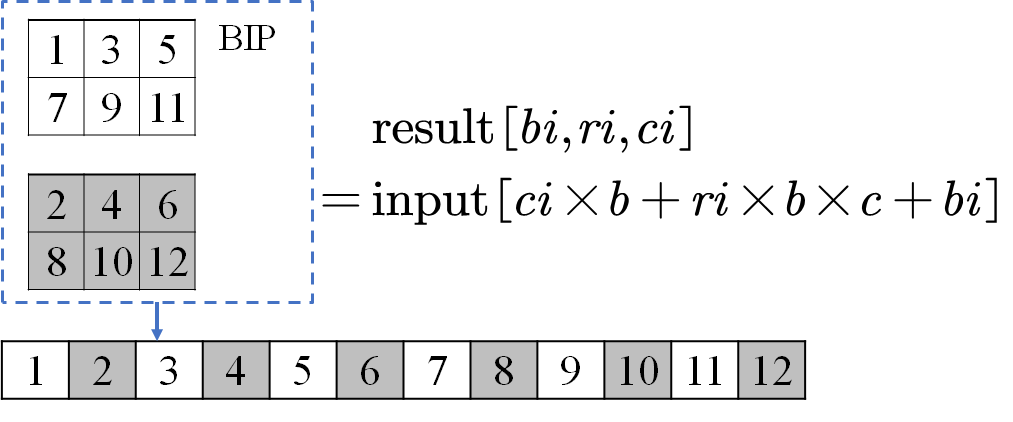
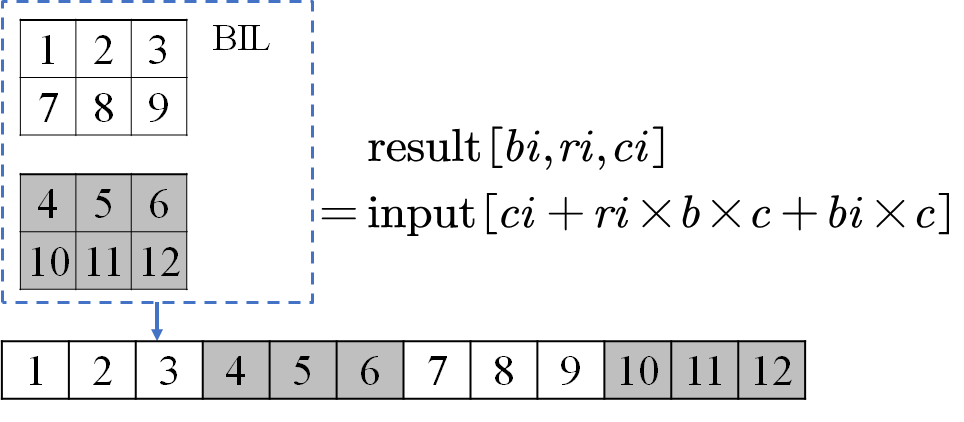
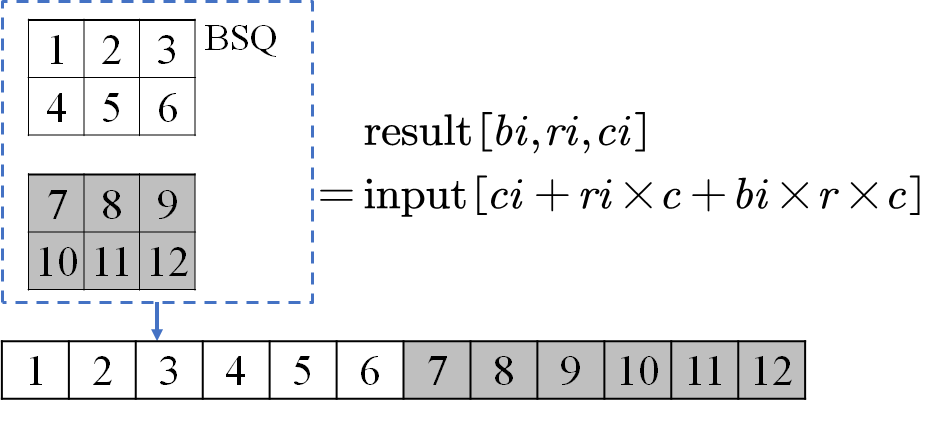
🍗MATLAB代码
笔者根据自己理解,编写了parserData的MATLAB函数。并利用ENVI软件制作了BIL、BIP、BSQ格式的RGB图片文件,使用MATLAB读取数据文件经过解析后简单绘制可视化。
读取效果
BIP读取
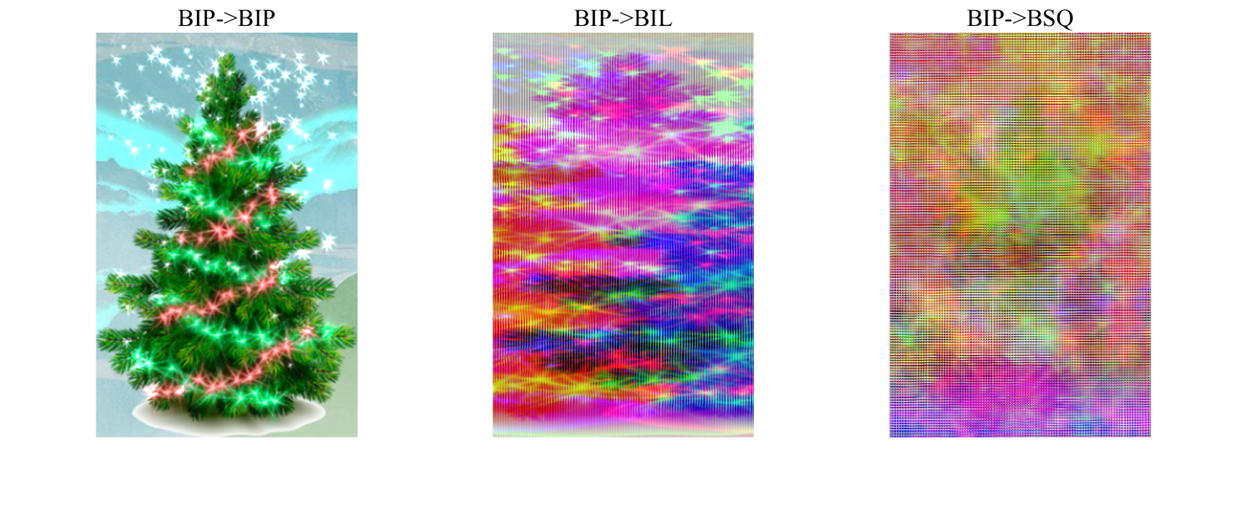
BIL读取
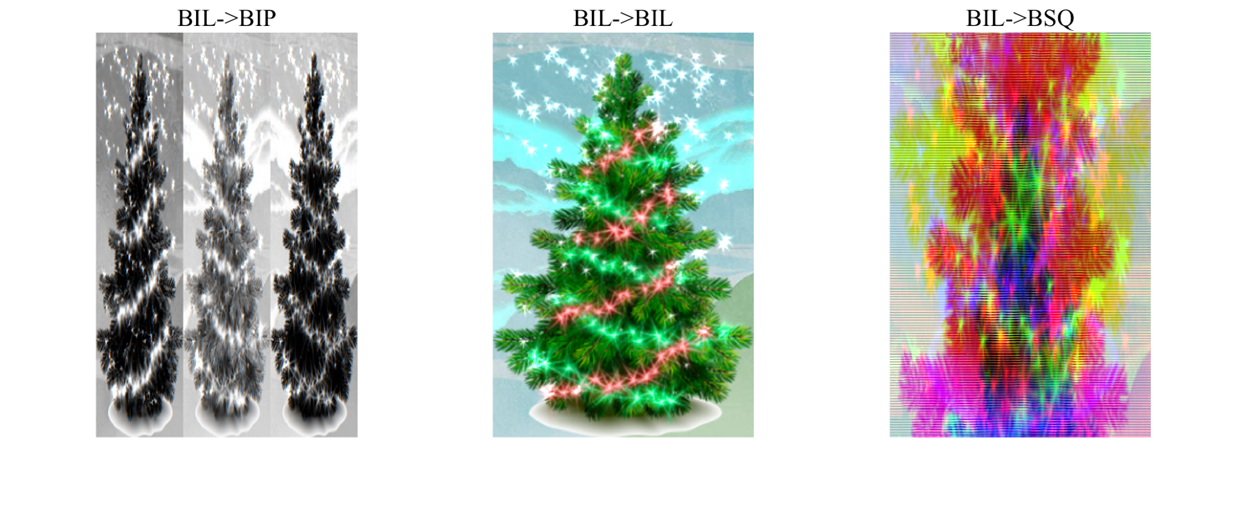
BSQ读取
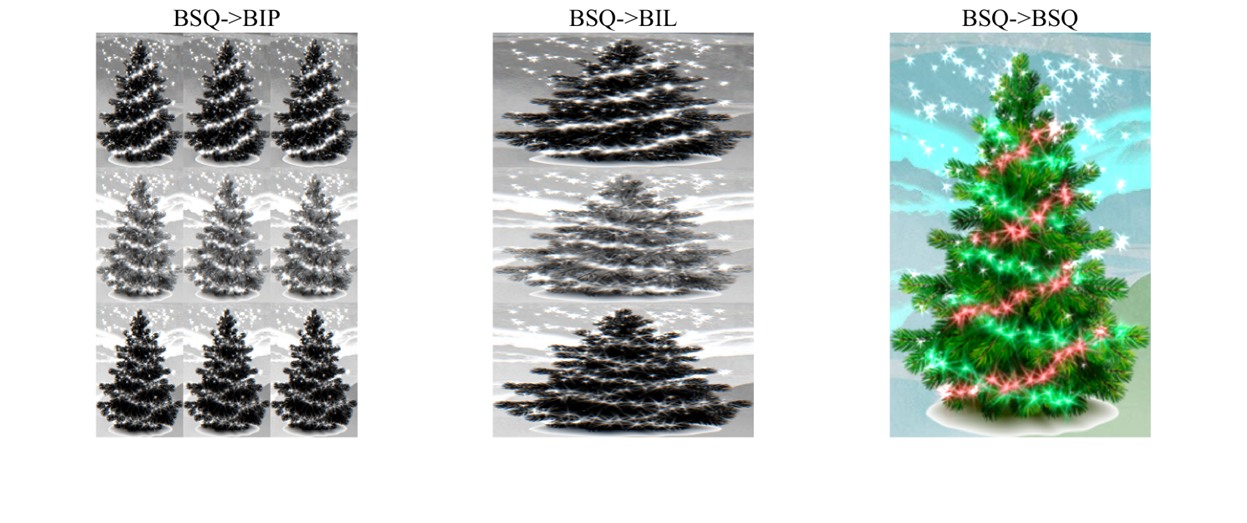
parserData.m
function result = parseData(lineData, row, column, bandcount, type)
% 解析一维数组到BIP、BIL、BSQ格式
totalsize = length(lineData);
result = zeros([row, column, bandcount]);
% 解析BIP格式
if upper(type) == "BIP"
for i = 1:bandcount
tmp = lineData(i:bandcount:totalsize);
result(:, :, i) = reshape(tmp, column, row)';
end
% 解析BIL格式
elseif upper(type) == "BIL"
tmp = reshape(lineData, bandcount*column, row);
for i = 1:bandcount
result(:, :, i) = tmp(column*(i - 1)+1:column*i, :)';
end
% 解析BSQ格式
elseif upper(type) == "BSQ"
tmp = reshape(lineData, column, row*bandcount)';
for i = 1:bandcount
result(:, :, i) = tmp(row*(i - 1)+1:row*i, :);
end
end
end
demo.m
clear, clc, close all;
type = "BIP";
filepath = strcat("../", type, "/tree", type);
filehead = strcat(filepath, ".hdr");
% 1.读取数据到一维数组
fileID = fopen(filepath, 'r');
if (fileID == -1)
disp(strcat(filepath, "---OpenFailed"));
end
fileData = fread(fileID, "uint8");
types = ["BIP", "BIL", "BSQ"];
% 2.解析数据,并绘图
for i = 1:length(types)
figure
data = parseData(fileData, 465, 300, 3, types(i));
imshow(uint8(data));
resultName = strcat("../", type, "/result", types(i), ".png");
title(strcat(type, "->", types(i)), 'FontSize', 14, 'FontName', 'Times New Roman')
print(gcf, '-dpng','-r300', resultName);
end
🍟C++代码
C++主要是利用ifstream函数读取二进制文件,存储到vector数组,编写一个模板类Parser以便解析一维数组。
由于笔者能力有限,并未做C++的图行可视化,通过编写test函数生成简单一维数组调用类进行解析以测试类的可靠性,通过输出读取图像第一个像元值来与ENVI软件、取色值软件所探测得到的RGB做对比以测试读取的正确性。
Parser.hpp
#pragma once
#include <vector>
using namespace std;
template<typename T>
class Parser {
public:
vector<T> lineData;
public:
Parser(const vector<T> lineData);
void BIP(int r, int c, int b,
vector<vector<vector<T>>>& result);
void BIL(int r, int c, int b,
vector<vector<vector<T>>>& result);
void BSQ(int r, int c, int b,
vector<vector<vector<T>>>& result);
};
template<typename T>
Parser<T>::Parser(const vector<T> lineData) {
this->lineData = lineData;
}
template<typename T>
void Parser<T>::BIP(int r, int c, int b,
vector<vector<vector<T>>>& result) {
result.clear();
for (int bi = 0; bi < b; bi++) {
vector<vector<T>> bandData(r, vector<T>(c));
for (int ri = 0; ri < r; ri++) {
for (int ci = 0; ci < c; ci++) {
int ind = ci * b + ri * b * c + bi;
bandData[ri][ci] = lineData[ind];
}
}
result.push_back(bandData);
}
}
template<typename T>
void Parser<T>::BIL(int r, int c, int b,
vector<vector<vector<T>>>& result) {
result.clear();
for (int bi = 0; bi < b; bi++) {
vector<vector<T>> bandData(r, vector<T>(c));
for (int ri = 0; ri < r; ri++) {
for (int ci = 0; ci < c; ci++) {
int ind = ci + ri * b * c + bi * c;
bandData[ri][ci] = lineData[ind];
}
}
result.push_back(bandData);
}
}
template<typename T>
void Parser<T>::BSQ(int r, int c, int b,
vector<vector<vector<T>>>& result) {
result.clear();
for (int bi = 0; bi < b; bi++) {
vector<vector<T>> bandData(r, vector<T>(c));
for (int ri = 0; ri < r; ri++) {
for (int ci = 0; ci < c; ci++) {
int ind = bi * r * c + ri * c + ci;
bandData[ri][ci] = lineData[ind];
}
}
result.push_back(bandData);
}
}
Demo.cpp
#include <stdio.h>
#include <fstream>
#include <vector>
#include "Parser.hpp"
using namespace std;
template <typename T>
void print(vector < vector<vector<T>>>& result) {
for (auto& band : result) {
for (auto& row : band) {
for (auto& pixel : row) {
printf("%d ", pixel);
}
printf("\n");
}
printf("\n");
}
}
void test() {
vector<int> lineData(24);
for (int i = 0; i < 24; i++) {
lineData[i] = i + 1;
}
int row = 2, column = 3, bandcount = 2;
Parser<int> parser(lineData);
vector<vector<vector<int>>> result;
parser.BIP(row, column, bandcount, result);
//parser.BIL(row, column, bandcount, result);
//parser.BSQ(row, column, bandcount, result);
print(result);
}
int main() {
test(); //简单测试Parser类的函数
string filepath = "./../../BIP/treeBIP"; //二进制文件路径
int row = 465, column = 300, bandcount = 3; //自己定义的行、列、波段数
int size = row * column * bandcount;
typedef uint8_t datatype;//影像存储数据类型
//1.读取二进制文件到一维数组
ifstream inFile(filepath, ios::in | ios::binary);
if (!inFile) {
printf("Error: Cannot open file\n");
return 0;
}
vector<datatype> lineData(size);
inFile.read(reinterpret_cast<char*>(&lineData[0]), size * sizeof(datatype));
inFile.close();
//2.解析一维数组
vector<vector<vector<datatype>>> result;
Parser<datatype> parser(lineData);
parser.BIP(row, column, bandcount, result);
printf("%d %d %d",result[0][0][0],result[1][0][0],result[2][0][0]);
return 0;
}
🍕项目文件获取
有关本文所涉及的案例代码,均可通过关注本公众号,后台私信回复“241107”获取~
🌹结语
-
笔者为测绘遥感方向的学习者,愿意结交志同道合的伙伴,欢迎关注公众号与笔者一起交流学习~
-
关于影像的大小(size)和存储格式等信息,均可从影像数据的元数据文件获取~
-
在MATLAB代码中,读取后的数组索引应该为[row][column][band],在C++代码中,索引为[band][row][column],这是由于MATLAB和C++数组取值便捷性而设计的~
-
路虽远,行则将至;事虽难,做则必成。希望认真学习的您能够有所收获~
-
本公众号的原创成果,在未经允许的情况下,请勿用于任何商业用途!
-
如果本文有幸可以帮到您,欢迎您的点赞👍、收藏⭐与关注❤;您的点赞👍、收藏⭐与关注❤是我创作的最大动力~




